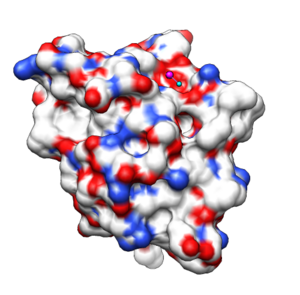Receiver domain of sensor histidine kinase CKI1
From Proteopedia
| Line 1: | Line 1: | ||
| - | [[Image: | + | [[Image:Receiver_domain_surf.png|300px|left|thumb| Receiver domain of CKI1 from ''Arabidopsis'', [[3mmn]]]] |
| + | '''Receiver domain of sensor histidine kinase CKI1''' (CKI1RD) catalyses the transphosphorylation reaction during hormonal and abiotic signalling in plants. Membrane-bound histidine kinase Cytokinin-independet 1 '''(CKI1)''' is a member of the Multistep phosphorelay '''(MSP)''' signalling pathway in ''Arabidopsis''. CKI1 was found to be constitutively active activator of a cytokinin-like response. Intracellularly located C-terminal CKI1RD is responsible for the recognition of CKI1 downstream signalling partners from family of Arabidopsis histidine-containing phosphotransfer proteins '''(AHP)''' and triggers the cytokine-like signal transmission. Divalent magnesium ion bound in the active site of CKI1RD is essential for the transphosphorylation reaction. Crystal structure of CKI1RD was determined as magnesium free and magnesium bound form. Magnesium binding induces the rearrangement of residues around the active site of CKI1RD, as was determined by both X-ray crystallography and NMR spectroscopy. | ||
| + | ==Biological Role== | ||
Revision as of 21:44, 7 June 2012

Receiver domain of sensor histidine kinase CKI1 (CKI1RD) catalyses the transphosphorylation reaction during hormonal and abiotic signalling in plants. Membrane-bound histidine kinase Cytokinin-independet 1 (CKI1) is a member of the Multistep phosphorelay (MSP) signalling pathway in Arabidopsis. CKI1 was found to be constitutively active activator of a cytokinin-like response. Intracellularly located C-terminal CKI1RD is responsible for the recognition of CKI1 downstream signalling partners from family of Arabidopsis histidine-containing phosphotransfer proteins (AHP) and triggers the cytokine-like signal transmission. Divalent magnesium ion bound in the active site of CKI1RD is essential for the transphosphorylation reaction. Crystal structure of CKI1RD was determined as magnesium free and magnesium bound form. Magnesium binding induces the rearrangement of residues around the active site of CKI1RD, as was determined by both X-ray crystallography and NMR spectroscopy.
